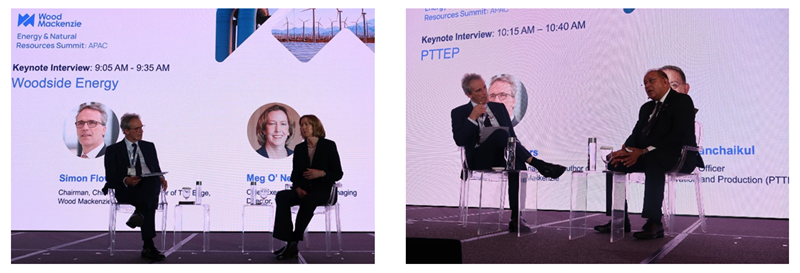Sign up today to get the best of our expert insight in your inbox.
Rebooting Asia’s energy transition
Five takeaways from energy sector CEOs
4 minute read
Simon Flowers
Chairman, Chief Analyst and author of The Edge

Simon Flowers
Chairman, Chief Analyst and author of The Edge
Simon is our Chief Analyst; he provides thought leadership on the trends and innovations shaping the energy industry.
Latest articles by Simon
-
The Edge
Upstream’s mounting challenge to deliver future oil supply
-
The Edge
A world first: shipping carbon exports for storage
-
The Edge
WoodMac’s Gas, LNG and the Future of Energy conference: five key themes
-
The Edge
Nigeria’s bold strategy to double oil production
-
The Edge
US tariffs – unpredictability is the strategic planners’ nightmare
-
The Edge
US upstream gas sector poised to gain from higher Henry Hub prices
Gavin Thompson
Vice Chairman, Energy – Europe, Middle East & Africa

Gavin Thompson
Vice Chairman, Energy – Europe, Middle East & Africa
Gavin oversees our Europe, Middle East and Africa research.
Latest articles by Gavin
-
The Edge
A world first: shipping carbon exports for storage
-
The Edge
WoodMac’s Gas, LNG and the Future of Energy conference: five key themes
-
The Edge
Nigeria’s bold strategy to double oil production
-
The Edge
US tariffs – unpredictability is the strategic planners’ nightmare
-
The Edge
Upside pressure mounts on US gas prices
-
The Edge
The coming geothermal age
Last week in Singapore, sector leaders, including CEOs, took to the stage for Wood Mackenzie’s 6th APAC Energy and Natural Resources Summit. The theme was ‘Rebooting Asia’s energy transition’. Gavin Thompson and I identified five key takeaways.
The energy transition will take longer
More than two years since Russia invaded Ukraine, multiple speakers asserted that energy security and affordability remain firmly at the top of the agenda. While renewables have strong momentum, emerging low-carbon technologies are coming through more slowly than hoped.
Fossil fuels are the beneficiaries. Coal is notably resilient in the power sector, while upstream oil and gas is bouncing back in the region after years in the doldrums. Exploration and appraisal are delivering promising results, with Indonesia and Malaysia ranked second and fourth for discovered resources globally in 2023. The former announced another significant deepwater gas discovery just this week.
But it’s not all smooth sailing. Risks around regulations, costs and logistics continue to delay upstream FIDs across the region. TotalEnergies’ Papua LNG project is the latest to see sanction shunted from 2024 into 2025 due to rising costs. APAC lacks ‘advantaged resources’ – its average pre-FID emissions intensity of 30 kg/tCO2e is double the global average for pre-FID projects. Venting of CO2 is a particular challenge for some new projects and should act as a catalyst to rising investment in carbon capture, utilisation and storage (CCUS) as corporates seek to boost sustainability credentials and protect their social licence to operate.
Deal-making is back in vogue
APAC upstream M&A is full steam ahead, with Asian NOCs, non-traditional players, including private equity and sovereign wealth funds, and, interestingly, the European Majors all stepping up activity. As one senior banker commented, oil and gas companies are thinking bigger than the lending banks, and boards across the sector are open to much more ambitious M&A proposals than in previous years.
Recent deals by TotalEnergies in Malaysia and Eni in Indonesia show that Southeast Asia continues to offer upside potential. Part of the region’s attraction is its gas and LNG, the last great growth play in fossil fuels. Are we seeing a touch of FOMO from European Majors after their US counterparts went big in M&A in Q4 2023?
The Chinese NOCs remain something of an enigma in upstream M&A as political considerations continue to weigh heavily on international ambitions. The same can’t be said for their counterparts in metals. Chinese miners are still chasing pretty much everything – often with success at the end of the deal process.
Power generation is not an “easy to decarbonise” sector
The decarbonisation debate often refers to the “hard to abate” sectors like steel, aviation and shipping, implying that electric power is more straightforward. The bad news is that the power sector is not that easy either. China is a case in point. Last year, China installed a mind-blowing 257 GWdc of solar – eight times more than the US – in addition to 75 GWac of wind capacity. Yet even this was not enough to fully meet China’s 2023 electricity demand growth. Coal plants filled much of the gap.
Across many Asian markets, it’s the same story as power demand growth outpaces the expansion of renewables. Investment in renewables and energy storage must scale up apace.
Finance is available for emerging low-carbon technologies
But projects aren’t progressing fast enough due to a lack of financial incentives, subsidies and a meaningful carbon price. Across the region, end-users are not yet willing to pay higher prices to kickstart markets.
CCUS is one example. APAC accounts for 53% of gross global emissions, with three-quarters of global coal plants and steel and cement production based in the region. Yet the carbon capture sector remains in its infancy here, accounting for just 19% of proposed projects worldwide. Current Asian projects are largely focused on decarbonising supply. What’s needed is CCUS at scale in hubs, serving large industrial clusters with high emissions concentration. The right policies and subsidies must be developed to get things moving – better still, a meaningful carbon price. CCUS needs leaders to get things going, including the global players who are making faster progress in the US and Europe.
Policy is key to momentum on low-carbon energy investment
Carbon prices across Asia Pacific remain either too low or non-existent. Few in the room held much hope this would change quickly. Instead, governments will need to offer carrots to spark investment. With affordability fundamental to policy across the region, this is going to take time.
Predicting government policy remains one of the biggest challenges in renewables. Australia’s government support scheme aimed at adding a further 32 GW of renewable capacity by 2030 is one example of how changing legislation can impact value. Developers with wind and solar capacity already in operation will not benefit from the scheme, meaning their assets are likely worth less than when they originally invested. Such incremental policy decisions driven by governments learning on the job could well be a feature of future power markets.
Can Asia reboot it's energy transition? It’s going to take time and money, but we hope last week’s APAC Energy and Natural Resources Summit at least succeeded in identifying what needs to be done.
Many thanks to Meg O’Neill, Chief Executive Officer & Managing Director, Woodside Energy, and to Montri Rawanchaikul, Chief Executive Officer, PTT Exploration and Production (PTTEP) among the senior industry leaders who joined us.
Make sure you get The Edge
Every week in The Edge, Simon Flowers curates unique insight into the hottest topics in the energy and natural resources world.








